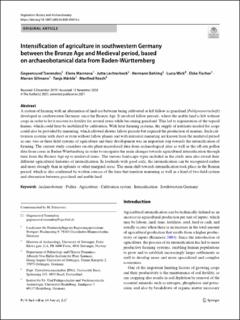| dc.contributor.author | Tserendorj, Gegeensuvd | |
| dc.contributor.author | Marinova, Elena | |
| dc.contributor.author | Lechterbeck, Jutta | |
| dc.contributor.author | Behling, Hermann | |
| dc.contributor.author | Wick, Lucia | |
| dc.contributor.author | Fischer, Elske | |
| dc.contributor.author | Sillmann, Marion | |
| dc.contributor.author | Märkle, Tanja | |
| dc.contributor.author | Rösch, Manfred | |
| dc.date.accessioned | 2023-02-22T11:54:06Z | |
| dc.date.available | 2023-02-22T11:54:06Z | |
| dc.date.created | 2021-01-11T09:19:29Z | |
| dc.date.issued | 2021 | |
| dc.identifier.citation | Tserendorj, G., Marinova, E., Lechterbeck, J., Behling, H., Wick, L., Fischer, E., ... & Rösch, M. (2021). Intensification of agriculture in southwestern Germany between the Bronze Age and Medieval period, based on archaeobotanical data from Baden-Württemberg. Vegetation History and Archaeobotany, 30, 35-46. | en_US |
| dc.identifier.issn | 0939-6314 | |
| dc.identifier.uri | https://hdl.handle.net/11250/3053228 | |
| dc.description.abstract | A system of farming with an alternation of land use between being cultivated or left fallow as grassland (Feldgraswirtschaft) developed in southwestern Germany since the Bronze Age. It involved fallow periods, where the arable land is left without crops in order to let it recover its fertility for several years while becoming grassland. This led to regeneration of the topsoil humus, which could later be mobilized by cultivation. With later farming systems, the supply of nutrients needed for crops could also be provided by manuring, which allowed shorter fallow periods but required the production of manure. Such cultivation systems with short or even without fallow phases and with intensive manuring are known from the medieval period as one, two or three field systems of agriculture and their development was an important step towards the intensification of farming. The current study considers on-site plant macrofossil data from archaeological sites as well as the off-site pollen data from cores in Baden-Württemberg in order to recognize the main changes towards agricultural intensification through time from the Bronze Age up to medieval times. The various landscape types included in the study area also reveal their different agricultural histories of intensification. In lowlands with good soils, the intensification can be recognized earlier and more strongly than in uplands or other marginal areas. The main shift towards intensification took place in the Roman period, which is also confirmed by written sources of the time that mention manuring as well as a kind of two field system and alternation between grassland and arable land. | en_US |
| dc.language.iso | eng | en_US |
| dc.publisher | Springer | en_US |
| dc.rights | Navngivelse 4.0 Internasjonal | * |
| dc.rights.uri | http://creativecommons.org/licenses/by/4.0/deed.no | * |
| dc.title | Intensification of agriculture in southwestern Germany between the Bronze Age and Medieval period, based on archaeobotanical data from Baden-Württemberg | en_US |
| dc.type | Peer reviewed | en_US |
| dc.type | Journal article | en_US |
| dc.description.version | publishedVersion | en_US |
| dc.rights.holder | The authors | en_US |
| dc.subject.nsi | VDP::Humaniora: 000::Arkeologi: 090 | en_US |
| dc.source.pagenumber | 35-46 | en_US |
| dc.source.volume | 30 | en_US |
| dc.source.journal | Vegetation History and Archaeobotany | en_US |
| dc.identifier.doi | 10.1007/s00334-020-00814-x | |
| dc.identifier.cristin | 1868561 | |
| cristin.ispublished | true | |
| cristin.fulltext | original | |
| cristin.qualitycode | 1 | |

